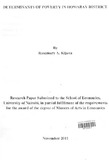| dc.description.abstract | Poverty estimates in Kenya reveal that poverty has been on the increase over time. This is despite efforts to eradicate the vice. Different areas differ markedly in resource endowment, geographical climatic conditions and in institutional arrangements. Therefore, alleviating poverty require an understanding of determinants of poverty in each specific area. The main objective of this study was to analyze the determinants of poverty in HomaBay district and suggests policies for reducing poverty. A logit regression model was used. Data from Kenya Integrated Household Budget Survey (KIHBS) 2005/6 conducted by Kenya National Bureau of Statistics (KNBS) was used. A total of 164 households: 110 rural and 54 urban were studied.
The study used the national rural poverty line to determine the proportion of poor households in the district. The study found that 56% of the sample lives below poverty line. The result show that household size, age of the household head, male headed household, disability of the household head, rural location and engagement in agricultural activities increase probability of a household being poor. Contrary, the estimated marginal effects shows that ownership of parcel of land and livestock, household head being married, access to piped water for drinking, household head post primary education level and his ability to read and write reduces the probability of household being poor. Several poverty eradication measures were recommended: provision of public goods such as good roads, electricity supply and piped water; boosting education level in HomaBay district; provision of free or affordable health care services, including family planning services to the poor and introduction of special life sustenance programs/mechanisms targeted to the physically disabled person. Others include improved land management and access to farmland. | en_US |

